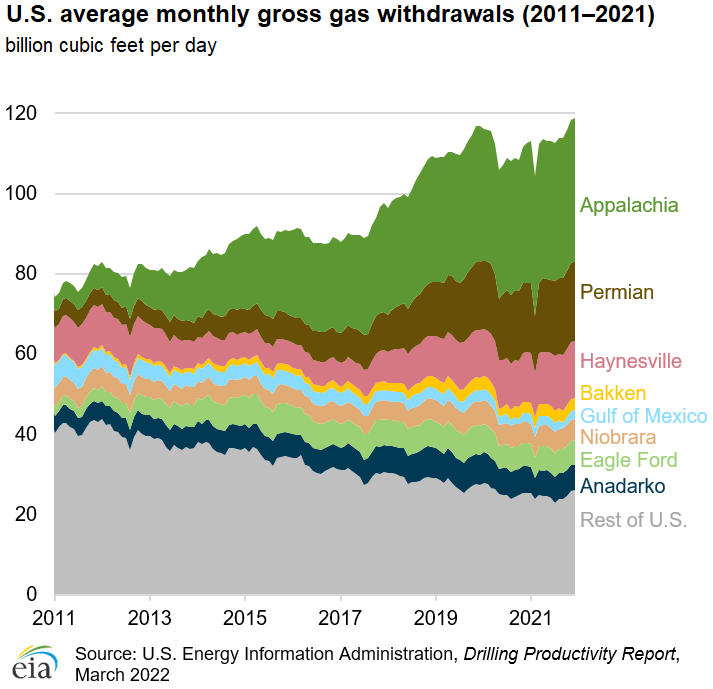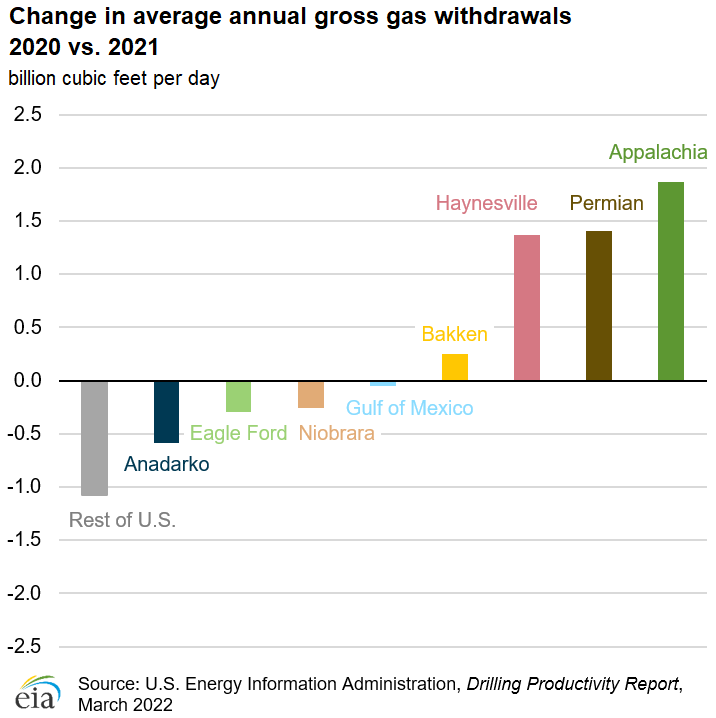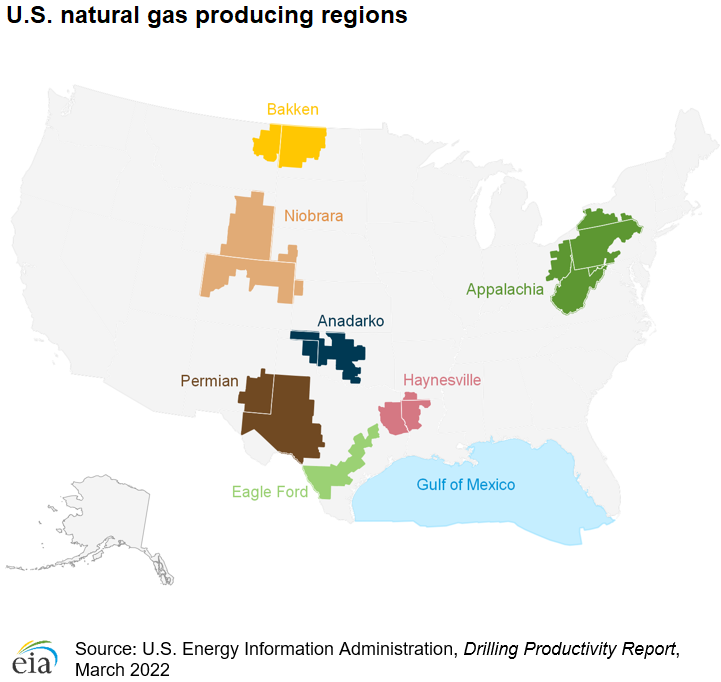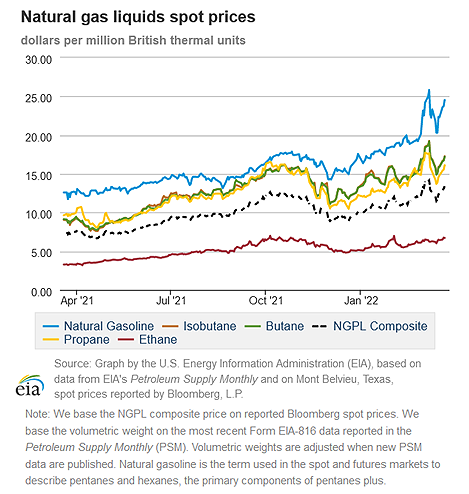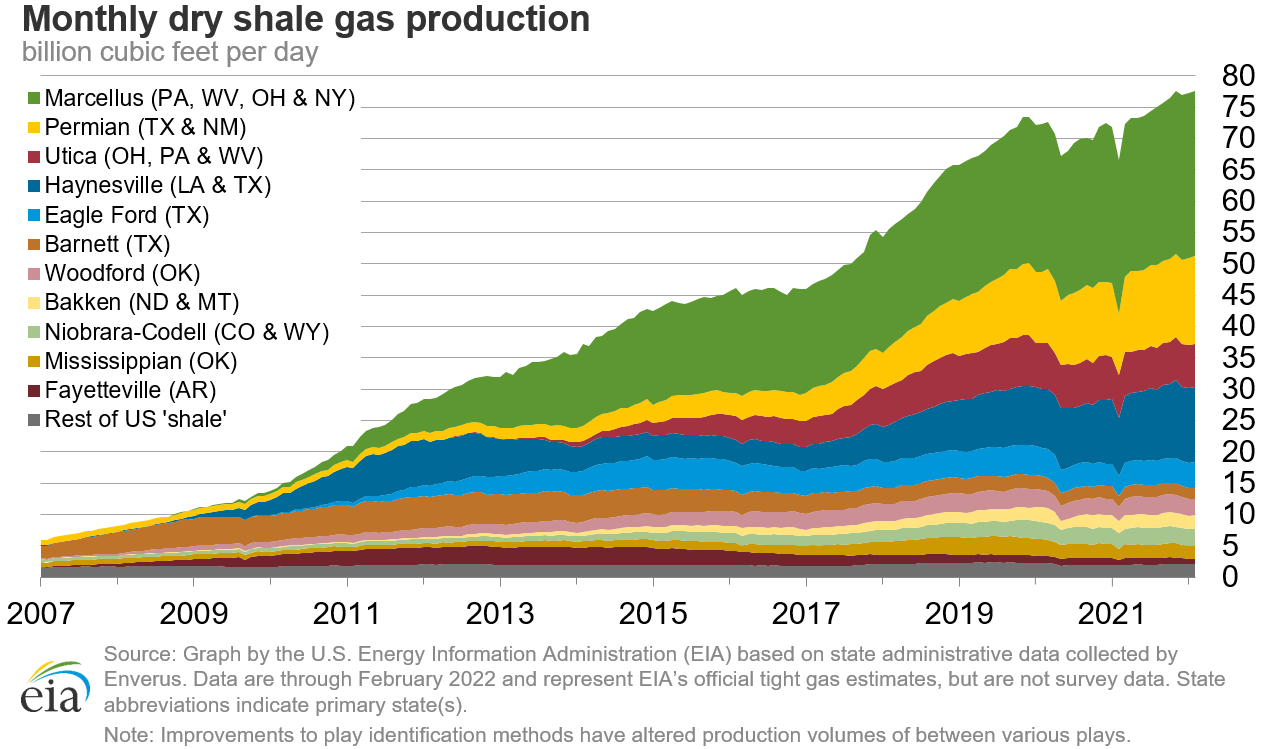In the News:
Most U.S. gross gas withdrawals and production growth occurred in the Appalachia, Permian, and Haynesville regions in 2021
In 2021, gross natural gas withdrawals in the United States rose by 2% over 2020 levels and reached a new high of 118.8 billion cubic feet per day (Bcf/d) in December 2021. The Appalachia, Permian, and Haynesville regions accounted for 59% of gross withdrawals in 2021 compared with 24% in 2011.
The Appalachia region in the Northeast accounted for 33.1 Bcf/d of gross withdrawals in 2020 and rose by another 1.9 Bcf/d in 2021. Currently, Appalachia accounts for 31% of domestic gross withdrawals. Production growth in Appalachia in the past ten years has been the result of pipeline buildouts and increased takeaway capacity; however, going forward, we estimate growth in Appalachia will be limited by fewer new pipeline capacity additions.
The Permian region in western Texas and New Mexico accounted for 16.9 Bcf/d of gross withdrawals in 2020, and rose to 18.3 Bcf/d, or 16% of the total U.S. gross withdrawals, in 2021. The deployment of oil-directed rigs in the Permian region and the subsequent rise in associated gas production is a result of increasing crude oil prices; the Brent crude oil price rose from a low of $50 per barrel (b) in early January 2021 to as high as $78/b by late December.
Gross natural gas withdrawals in the Haynesville region in Louisiana and Texas grew by 1.4 Bcf/d in 2021 to 13.2 Bcf/d, or 12% of total U.S. natural gas withdrawals. As natural gas prices remain elevated, drilling in the Haynesville remains economical, even though it requires relatively deeper and more expensive wells. The higher development costs are offset by the region’s higher well productivity and its proximity to the Gulf Coast, where natural gas demand has been growing rapidly from liquefied natural gas export terminals and industrial facilities.
In contrast to the Appalachia, Permian, and Haynesville regions, the Federal Offshore Gulf of Mexico (GOM) had a declining share of gas withdrawals. The region accounted for 2% of gross gas withdrawals in 2021, compared with 6% of gross gas withdrawals in 2011. Extracting natural gas from below the seabed tends to be expensive, and U.S. producers have generally lowered investments in natural gas-directed offshore projects.
Overview:
(For the week ending Wednesday, March 23, 2022)
- Spot Prices: Natural gas spot prices rose at most locations this report week (Wednesday, March 16 to Wednesday, March 23). The Henry Hub spot price rose from $4.67 per million British thermal units (MMBtu) last Wednesday to $5.26/MMBtu yesterday.
- International Spot Prices: International natural gas spot prices declined this report week but have remained elevated since the start of Russia’s further invasion of Ukraine on February 24, which has increased uncertainty in European natural gas markets. Bloomberg Finance, L.P. reports that swap prices for liquefied natural gas (LNG) cargos in East Asia for the balance of March fell $3.07/MMBtu to a weekly average of $35.55/MMBtu. At the Title Transfer Facility (TTF) in the Netherlands, the most liquid natural gas spot market in Europe, the day-ahead prices fell $4.66 to a weekly average of $32.82/MMBtu. In the same week last year (week ending March 24, 2021), prices in East Asia and at TTF were $6.63/MMBtu and $6.35/MMBtu, respectively.
- Futures: The price of the April 2022 NYMEX contract increased 48.4 cents, from $4.748/MMBtu last Wednesday to $5.232/MMBtu yesterday. The price of the 12-month strip averaging April 2022 through March 2023 futures contracts climbed 46.5 cents to $5.359/MMBtu.
- Storage: The net withdrawals from working gas totaled 51 billion cubic feet (Bcf) for the week ending March 18. Working natural gas stocks totaled 1,389 Bcf, which is 21% lower than the year-ago level and 17% lower than the five-year (2017–2021) average for this week.
- NGPLs: The natural gas plant liquids composite price at Mont Belvieu, Texas, rose by 67 cents/MMBtu, averaging $12.83/MMBtu for the week ending March 23. Prices of natural gasoline, butanes, and propane rose, following the price of Brent crude oil, which rose 6% week over week. The natural gasoline price increased by 8%, and the prices of normal butane and isobutane both rose by 4%. The propane price rose by 5%, widening the propane discount to crude oil by 10%. The ethane price increased by 6% week over week, more than the weekly average natural gas price at the Houston Ship Channel, which rose by 3%. The ethane premium to natural gas increased by 22 cents/MMBtu (12%) to $2.14/MMBtu.
- Rigs: According to Baker Hughes, for the week ending Tuesday, March 15, the natural gas rig count increased by 2 to 137 rigs. The Haynesville and the Permian each added one rig; one rig was added in an unspecified location; and the Marcellus dropped one rig. The Haynesville now accounts for 47% of all active gas-directed rigs. The number of oil-directed rigs decreased by 3 to 524 rigs. The Ardmore Woodford gained one rig, and one rig was lost in each of the following: the Eagle Ford, the Permian, the Williston, and an unspecified location. The total rig count now stands at 663, the highest level since April 3, 2020, and 252 rigs more than last year at this time.
Prices/Supply/Demand:
Prices along the Gulf Coast rise in response to rapidly cooling weather. This report week (Wednesday, March 16 to Wednesday, March 23), the Henry Hub spot price rose 59 cents from $4.67/MMBtu last Wednesday to $5.26/MMBtu yesterday. The Henry Hub price is now at a premium to all major North American natural gas markets except PG&E in Northern California. Temperatures along the Gulf Coast were colder than normal this report week. In Houston, Texas, the weekly average temperature was 62°F, which was 3°F lower than normal. Feedgas deliveries to LNG export terminals along the Gulf Coast were almost flat at 11.7 billion cubic feet per day (Bcf/d) this report week. Deliveries of feedgas to terminals in South Texas decreased 0.1 Bcf/d (3%) to 4.0 Bcf/d and those to South Louisiana increased 0.1 Bcf/d (1%) to 7.8 Bcf/d. Feedgas deliveries to Freeport LNG in Texas were reduced to minimal levels on Tuesday as a result of the feedgas not meeting specifications for “heating value after CO2 removal.” In Notice ID 5030161, Boardwalk Pipelines, operator of the Gulf South Pipeline that serves the terminal, requested that all nominations be taken down as low as possible. As of yesterday, feedgas deliveries had returned to over 1 Bcf/d.
Prices in the Midwest rise in line with Henry Hub. At the Chicago Citygate, the price increased 54 cents from $4.21/MMBtu last Wednesday to $4.75/MMBtu yesterday. Temperatures in the Chicago area averaged 50°F over the course of the report week, 10°F above normal for the week, resulting in lower weekly average natural gas consumption. Last Thursday the temperature reached a weekly high of 73°F in Chicago, 21°F above normal. Temperatures are expected to drop through the weekend.
Prices in the West increase, reflecting the general trend in prices across the United States. The price at PG&E Citygate in Northern California rose 40 cents, up from $5.14/MMBtu last Wednesday to $5.54/MMBtu yesterday, after dropping to a weekly low of $5.11/MMBtu last Thursday. The price at Malin, Oregon, the northern delivery point into the PG&E service territory, rose 40 cents from a weekly low of $4.16/MMBtu last Wednesday to a weekly high of $4.56/MMBtu yesterday. The price at Sumas on the Canada-Washington border, the main pricing point for the Pacific Northwest, rose 42 cents from $3.91/MMBtu last Wednesday to $4.33/MMBtu yesterday. Temperatures in Seattle, Washington averaged nearly 48°F, which is normal for this time of year. The price at SoCal Citygate in Southern California increased 53 cents from $4.22/MMBtu last Wednesday to $4.75/MMBtu yesterday. The National Oceanic and Atmospheric Administration (NOAA) reports temperatures in Riverside, California, inland from Los Angeles, averaged 67°F, which is 7°F higher than normal. Yesterday, Riverside reached a high of 90°F, which is 11°F higher than normal.
Prices in the Northeast rise in advance of below-normal temperatures going into the weekend. At the Algonquin Citygate, which serves Boston-area consumers, the price went up 95 cents from $4.01/MMBtu last Wednesday to $4.96/MMBtu yesterday. At the Transcontinental Pipeline Zone 6 trading point for New York City, the price increased 54 cents from $3.88/MMBtu last Wednesday to $4.42/MMBtu yesterday. Prices increased in line with near-term forecasts for below-normal temperatures ahead of the weekend.
Prices in the Appalachia production region increase in line with neighboring regions. The Tennessee Zone 4 Marcellus spot price increased 61 cents from $3.72/MMBtu last Wednesday to $4.33/MMBtu yesterday. The price at Eastern Gas South in southwest Pennsylvania rose 60 cents from $3.78/MMBtu last Wednesday to $4.38/MMBtu yesterday. Natural gas production was essentially flat this week at 33.3 Bcf/d. Net natural gas flows out of the Appalachia production region to the southern corridor increased 1.0 Bcf/d (17%) this report week to an average 7.2 Bcf/d, according to PointLogic. So far this month natural gas flows to the southern corridor have averaged 6.7 Bcf/d compared with 5.2 Bcf/d for all of February. At the same time, as a result of decreasing demand from the Mid-Atlantic up to New England, natural gas flows to the New York and New Jersey area declined by 1.9 Bcf/d (20%) to an average of 7.6 Bcf/d this report week.
Prices in the Permian production region rise, narrowing the discount to Henry Hub. The price at the Waha Hub in West Texas, which is located near Permian Basin production activities, rose 75 cents this report week, from $3.65/MMBtu last Wednesday to $4.40/MMBtu yesterday. The Waha Hub traded 86 cents below the Henry Hub price yesterday, compared with last Wednesday when it traded $1.02 below the Henry Hub price. According to data from PointLogic, net natural gas flows out of the region increased 0.4 Bcf/d (3%) to 13.5 Bcf/d led by an increase in eastbound flows of 0.4 Bcf/d (5%) to an average of 8.6 Bcf/d for the week. The increase in natural gas flows was tempered by a decline of 0.1 Bcf/d (10%) in flows to the south.
An increase in U.S. natural gas production is offset by a decrease in imports from Canada. According to data from PointLogic, the average total supply of natural gas rose slightly by 0.3% (0.3 Bcf/d) compared with the previous report week. Dry natural gas production grew by 1.1% (1.0 Bcf/d) compared with the previous report week. Average net imports from Canada decreased by 13.9% (0.7 Bcf/d) from last week.
A decline in U.S. natural gas consumption is led by the residential and commercial sectors. Total U.S. consumption of natural gas fell by 18.6% (15.8 Bcf/d) compared with the previous report week, according to data from PointLogic. Natural gas consumed for power generation declined by 7.0% (1.9 Bcf/d) week over week. Industrial sector consumption decreased by 5.5% (1.3 Bcf/d). In the residential and commercial sectors, consumption declined by 37.1% (12.6 Bcf/d). Heating demand declined over the past week as temperatures across most of the United States were above normal. Natural gas exports to Mexico decreased 4.8% (0.3 Bcf/d). Natural gas deliveries to U.S. LNG export facilities (LNG pipeline receipts) averaged 12.9 Bcf/d, the same as last week.
U.S. LNG exports increase by one vessel this week from last week. Twenty-three LNG vessels (eight from Sabine Pass; four each from Cameron, Corpus Christi, and Freeport; and one each from Calcasieu Pass, Cove Point, and Elba Island) with a combined LNG-carrying capacity of 85 Bcf departed the United States between March 17 and March 23, according to shipping data provided by Bloomberg Finance, L.P.
Storage:
The net withdrawals from storage totaled 51 Bcf for the week ending March 18, compared with the five-year (2017–2021) average net withdrawals of 62 Bcf and last year's net withdrawals of 29 Bcf during the same week. Working natural gas stocks totaled 1,389 Bcf, which is 293 Bcf lower than the five-year average and 366 Bcf lower than last year at this time.
According to The Desk survey of natural gas analysts, estimates of the weekly net change to working natural gas stocks ranged from net withdrawals of 42 Bcf to 69 Bcf, with a median estimate of 60 Bcf.
The average rate of withdrawals from storage is 9% higher than the five-year average up to this point in the withdrawal season (November through March). If the rate of withdrawals from storage matched the five-year average of 1.2 Bcf/d for the remainder of the withdrawal season, the total inventory would be 1,373 Bcf on March 31, which is 293 Bcf lower than the five-year average of 1,666 Bcf for that time of year.
More storage data and analysis can be found on the Natural Gas Storage Dashboard and the Weekly Natural Gas Storage Report.
See also:
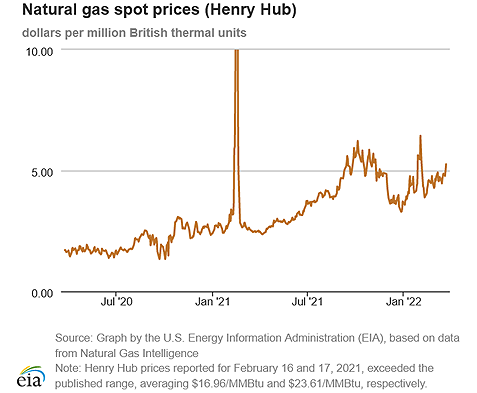
| Spot Prices ($/MMBtu) | Thu, 17-Mar |
Fri, 18-Mar |
Mon, 21-Mar |
Tue, 22-Mar |
Wed, 23-Mar |
|---|---|---|---|---|---|
| Henry Hub |
4.80 |
4.87 |
4.78 |
5.01 |
5.26 |
| New York |
3.80 |
3.82 |
3.93 |
4.12 |
4.42 |
| Chicago |
4.49 |
4.46 |
4.24 |
4.61 |
4.75 |
| Cal. Comp. Avg.* |
4.45 |
4.56 |
4.54 |
4.69 |
4.90 |
| Futures ($/MMBtu) | |||||
| April contract | 4.990 |
4.863 |
4.900 |
5.187 |
5.232 |
| May contract |
5.021 |
4.902 |
4.934 |
5.227 |
5.274 |
| *Avg. of NGI's reported prices for: Malin, PG&E Citygate, and Southern California Border Avg. | |||||
| Source: NGI's Daily Gas Price Index | |||||
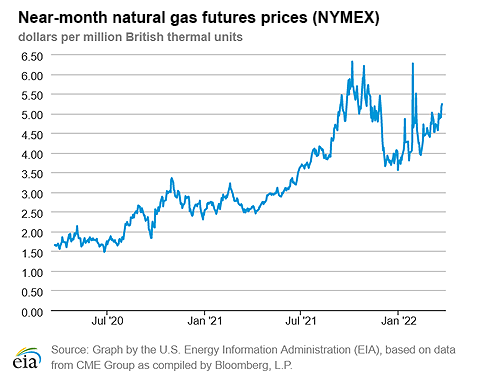
| U.S. natural gas supply - Gas Week: (3/17/22 - 3/23/22) | |||
|---|---|---|---|
Average daily values (billion cubic feet) |
|||
this week |
last week |
last year |
|
| Marketed production | 106.3 |
105.1 |
104.1 |
| Dry production | 94.0 |
93.0 |
91.8 |
| Net Canada imports | 4.3 |
5.0 |
4.8 |
| LNG pipeline deliveries | 0.1 |
0.1 |
0.1 |
| Total supply | 98.4 |
98.1 |
96.7 |
|
Source: Chart by the U.S. Energy Information Administration (EIA), based on data from PointLogic | |||
| U.S. natural gas consumption - Gas Week: (3/17/22 - 3/23/22) | |||
|---|---|---|---|
Average daily values (billion cubic feet) |
|||
this week |
last week |
last year |
|
| U.S. consumption | 69.2 |
85.0 |
77.7 |
| Power | 25.0 |
26.9 |
24.2 |
| Industrial | 22.9 |
24.2 |
22.6 |
| Residential/commercial | 21.3 |
33.9 |
31.0 |
| Mexico exports | 5.4 |
5.7 |
6.0 |
| Pipeline fuel use/losses | 6.5 |
6.9 |
6.6 |
| LNG pipeline receipts | 12.9 |
12.9 |
11.6 |
| Total demand | 93.9 |
110.4 |
101.9 |
|
Source: Chart by the U.S. Energy Information Administration (EIA), based on data from PointLogic | |||
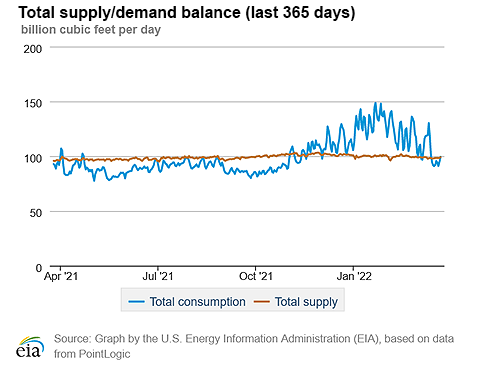
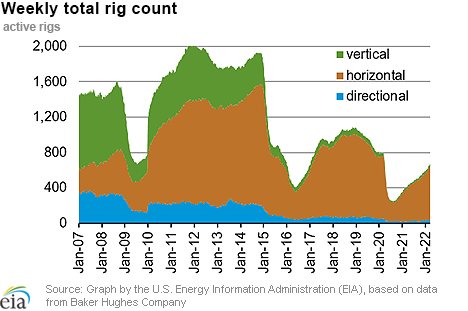
| Rigs | |||
|---|---|---|---|
Tue, March 15, 2022 |
Change from |
||
last week |
last year |
||
| Oil rigs | 524 |
-0.6% |
64.8% |
| Natural gas rigs | 137 |
1.5% |
48.9% |
| Note: Excludes any miscellaneous rigs | |||
| Rig numbers by type | |||
|---|---|---|---|
Tue, March 15, 2022 |
Change from |
||
last week |
last year |
||
| Vertical | 21 |
-8.7% |
-16.0% |
| Horizontal | 606 |
-0.2% |
62.9% |
| Directional | 36 |
9.1% |
157.1% |
| Source: Chart by the U.S. Energy Information Administration (EIA), based on data from Baker Hughes Company | |||
| Working gas in underground storage | ||||
|---|---|---|---|---|
Stocks billion cubic feet (Bcf) |
||||
| Region | 2022-03-18 |
2022-03-11 |
change |
|
| East | 268 |
290 |
-22 |
|
| Midwest | 318 |
337 |
-19 |
|
| Mountain | 87 |
87 |
0 |
|
| Pacific | 157 |
155 |
2 |
|
| South Central | 559 |
571 |
-12 |
|
| Total | 1,389 |
1,440 |
-51 |
|
|
Source: U.S. Energy Information Administration Form EIA-912, Weekly Underground Natural Gas Storage Report | ||||
| Working gas in underground storage | |||||
|---|---|---|---|---|---|
Historical comparisons |
|||||
Year ago (3/18/21) |
5-year average (2017-2021) |
||||
| Region | Stocks (Bcf) |
% change |
Stocks (Bcf) |
% change |
|
| East | 310 |
-13.5 |
303 |
-11.6 |
|
| Midwest | 408 |
-22.1 |
395 |
-19.5 |
|
| Mountain | 112 |
-22.3 |
99 |
-12.1 |
|
| Pacific | 194 |
-19.1 |
173 |
-9.2 |
|
| South Central | 731 |
-23.5 |
712 |
-21.5 |
|
| Total | 1,755 |
-20.9 |
1,682 |
-17.4 |
|
| Source: U.S. Energy Information Administration Form EIA-912, Weekly Underground Natural Gas Storage Report | |||||
| Temperature – heating & cooling degree days (week ending Mar 17) | ||||||||
|---|---|---|---|---|---|---|---|---|
HDDs |
CDDs |
|||||||
| Region | Current total |
Deviation from normal |
Deviation from last year |
Current total |
Deviation from normal |
Deviation from last year |
||
| New England | 178 |
-27 |
-18 |
0 |
0 |
0 |
||
| Middle Atlantic | 169 |
-22 |
-4 |
0 |
0 |
0 |
||
| E N Central | 186 |
-15 |
22 |
0 |
0 |
0 |
||
| W N Central | 203 |
3 |
34 |
0 |
-1 |
0 |
||
| South Atlantic | 116 |
2 |
37 |
12 |
1 |
-2 |
||
| E S Central | 122 |
15 |
77 |
0 |
-5 |
-7 |
||
| W S Central | 88 |
23 |
70 |
5 |
-6 |
-24 |
||
| Mountain | 170 |
10 |
-22 |
1 |
0 |
1 |
||
| Pacific | 78 |
-13 |
-63 |
0 |
-1 |
0 |
||
| United States | 145 |
-6 |
9 |
3 |
-1 |
-3 |
||
|
Source: Chart by the U.S. Energy Information Administration (EIA), based on data from the National Oceanic and Atmospheric Administration Note: HDDs=heating degree days; CDDs=cooling degree days | ||||||||
Average temperature (°F)
7-day mean ending Mar 17, 2022
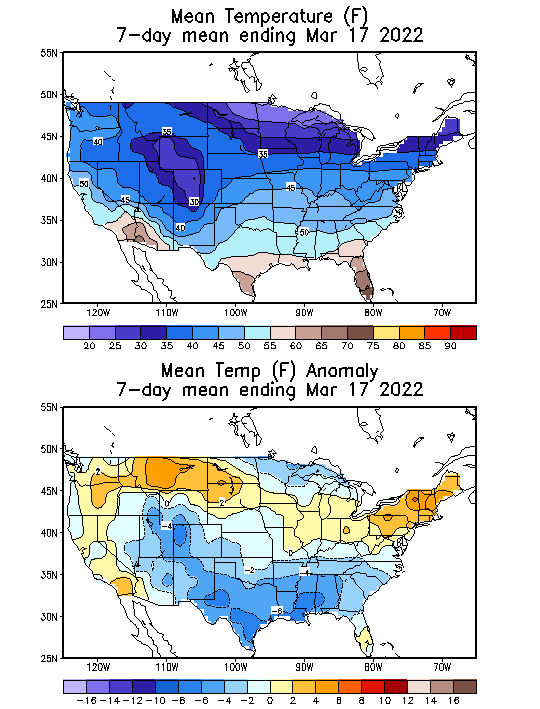
Source: National Oceanic and Atmospheric Administration Note: Image is not available.
Deviation between average and normal (°F)
7-day mean ending Mar 17, 2022

Source: National Oceanic and Atmospheric Administration Note: Image is not available.

